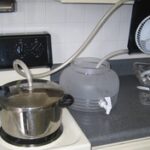How do you cool your home?
Do you set a fan to blow across a tub of boiling water and expect it to cool anything? Basically, here in New Mexico, that is the most common house design. It’s called a roof mounted swamp (evaporative) cooler. Now this design may work in milder climates. But here in the desert, where temperatures can reach over 100 degrees during the summer, it’s not the greatest idea.
Here is the problem with a roof mounted swamp cooler. You take a metal box which is intended to cool your home. Place that box directly in the sun. Not good enough? Place it on the roof, so the heat from the house itself rises to heat the box even more. Fill this box with water, turn on a fan inside of it and pump the air into your house. How much cooling do you think is occurring? Not much.
I’m sure the theory involved rests with the weight of cooler air sinking and the water added to the air being forced into the house having weight, as well. If you have a heat transfer system which takes the heat from inside the building, transports it to the roof and vents the heat to the outside, that theory is valid. Such devices exist but are generally impractical for anything less than a mansion or high rise building.
Some older homes already have swamp coolers installed. Between the cost of energy and environmental concerns, there has been increasing interest in the use of swamp coolers in recent years. Swamp coolers can be efficient devices and can keep your home quite comfortable. With the right installation or modifications and in the right environment.
First, let’s talk about environment. The effectiveness of a swamp cooler relies on the transfer of humidified air. If you live in an arid environment, they will work extremely well for you. However, the more humid the environment, the less effective they become. So, if you live in the desert, swamp coolers are a good idea. If you live next to the ocean, not so good.
Now, if you are considering installing a swamp cooler, consider the placement of it before purchasing one. There are different designs, with side draft and downdraft airflows. The best placement would be in an area which is shaded in the hottest part of the day. Try to keep it away from plants which may shed leaves or pollen which can clog the filters. Make sure you have easy access to the cooler because it’s best to do some routine maintenance every few weeks, which only takes a few minutes. Keep it away from garbage cans and dumpsters, because it will vent the odors directly into your house. If buying a new cooler, get the right size for your house. One that is too small would be as bad as having no cooling at all.
Some routine maintenance on swamp coolers may include checking the filters to make sure they’re clear, checking the water lines for leaks and oiling the bearings on most models. Get the special oil sold in hardware stores with a tube designed specifically for inverting the bottle and filling the oil reservoir. (You can refill the bottle with a different oil when it runs out if you like but pick an oil with no strong odor.) Don’t use spray oils, as your whole house will smell like oil for weeks. Swamp coolers have been known to attract and harbor nests of bees or yellowjackets. Adding a screen around the outside is not a bad idea. This can also help keep pollen and leaves away from the filter, so can pay for itself over time in reduced filter replacements. It’s also not a bad idea to add a filter to the water line if you live in a hard water area. Scale can build up on the filters, making them less efficient and reducing airflow. You can use chemicals to control scale and mildew. Or you can install an overflow device which automatically changes the water continuously at a slow rate. (If you use the overflow and no chemicals, you can divert the water to drip irrigate flower beds.) When doing maintenance, be sure to pull the filter panels off and make sure all the water distribution lines from the “spider” are dripping.
Now, if you have a swamp cooler like my own, which is roof mounted, all is not lost. You can modify the design to make it more efficient. Building a shelter around at least part of your cooler can do wonders for how well it cools your home. Last year, I had a tarp strung up to shade the cooler. However, it was tied to a tree which was too close to the house and had to be taken down before it damaged the foundation. So, recently I built a shelter around the cooler and the difference has been amazing. Today, the outdoor temperature was around 100 degrees. Inside, the temperature remained below 80 degrees.
Cost was a concern for me in building this shelter. So, I took four wooden pallets of sufficient size and used them to construct the shelter around three sides and the top of the cooler. Then I added a piece of plywood on the top to add more shade. Note: The fourth side of my cooler is the vent into the house. Then painted the whole thing white. Paint to preserve the wood and make it more presentable, white to reflect heat back and help keep things cool. The whole structure tilts for access to the cooler and then tilts back in place when done.
You can use different materials and make such a construct more decorative than my own. However, be sure it has plenty of space for air to pass through without resistance. Make sure you have access to all side of the cooler which have filters, fans or water lines for repairs and maintenance. If you have problems with bees or such, you’ll want to place screening on the outside of the shelter. In any case, be sure it offers shade to the cooler in the hottest parts of the day.
And remember, you must keep windows open a crack for swamp coolers to function. A swamp cooler works by forcing humidified air into the house and the air must have a place to flow outward. You can control how much cooling occurs in one room or another by opening windows in one room and closing them in another.




